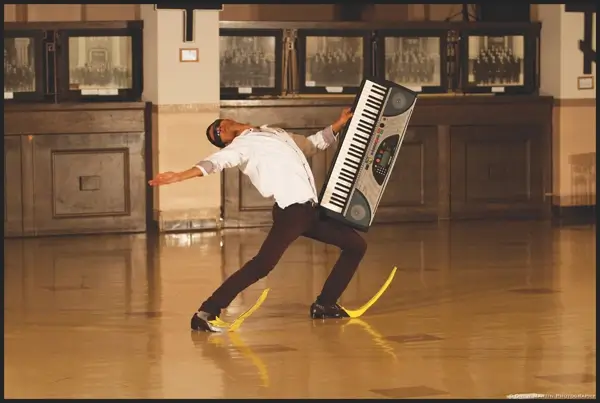
Dance Dance Evolution: Mudson’s DIY Choreography
Art
The term “modern dance,” for some, may bring to mind the scene in Donnie Darko where Cherita performs arabesques in a sparkling costume on a lavish stage, which may appease their sense of what dance is in an almost farcical way. Subtracting the excessive stage setup and costuming expected from dance, however, transforms its form.
Two dancers in blindfolds—unsure of whom the other is—take improvisational direction from an unseen choreographer via microphone as they balance their situational discomfort with their eagerness to perform; or, two women jump up and down from across the basement floor of the Masonic Temple, eerily in sync, as they strip to their underwear to exchange clothes—later, one pushes the other, who sits stubbornly on the floor, in a full circle around the room. Works in progress from local choreographers, such as these, challenge the canon of what dance can be, and underpin risk-taking in choreography.
In a world where the dance company model is dying and dancing in academia becomes increasingly cutthroat, Ashley Anderson’s Mudson stands as a beacon for local choreographers to show their own work. Anderson says, “I think it is one of few starting points. I don’t think there are a lot of options for people to present their work. Maybe you, offhand, get to show at a gallery, but the reality is: None of us are being asked … to be a resident artist.”
According to Anderson, the options for exhibiting work through dance companies dwindle. The major companies, like those of John Jasperse and Trisha Brown, may hire dancers, but only on a short-term basis, and there simply isn’t enough money to pay dancers a living wage. Additionally, university jobs providing free rehearsal space, rehearsal time and a wage are quickly disappearing, which often generates competition between dancers who all aspire to make and show work. Anderson has given choreographers the opportunity to show works in progress in the bi-seasonal Mudson series.
In 2010, Anderson started a 501(c)(3), Ashley Anderson Dances, in order to acquire funding for her work, and included the community-events branch, loveDANCEmore, which exhibits other artists’ work. Mudson is the flagship loveDANCEmore event, which strictly features works in progress from independent choreographers in the basement of the Masonic Temple, and will begin its third season on Sept. 17.
Mudson transcends the iniquity of the company model and academia: Rather than cloying for a long-term spot in a company by performing one choreographer’s work, or continuously justifying one’s work for the lofty standards of academia, Mudson applicants put their work on display in a way akin to a song in a rock band’s set—by just performing it. Instead of rigorously rehearsing a dance, then performing it once for scant reviews, Mudson lets artists test how their piece functions before a casual audience to glean how it works, which informs choreographers as to where to take the piece next—whether it be a large theatre or a coffee shop.
In their presentations of these pieces, choreographers are challenged by the DIY nature of Mudson. “It’s bare bones. You have to design it yourself,” says Anderson. Choreographers make artistic decisions using only four lights on a floor that’s atypical for dancing and must bring any additional equipment. Where universities have previously provided these amenities, Mudson compels artists to think critically as to how to present their choreography, which often leads to diversified outcomes. From the four pieces in a Mudson showcase, dances vary radically from each other, which allows the audience to explore what dance can be.
Seeing as how Mudson is free to attend, loveDANCEmore vies to let the audience make their own aesthetic judgment without having to discover their personal sense of what they like or what’s hip about dance through the façade of a ticket price. “You get to watch this great range of experiments happen, and whether they’re awesome or terrible, in your opinion, you get to see those aesthetics play out in a nuanced way,” says Anderson. With the otherworldly Masonic Temple basement— and its mysterious adornment and sigils of the masons— as Mudson’s venue, dance audiences can reformulate what they’ve come to expect from a formal stage setting and view dance through an altogether different frame.
By giving dance a second, alternative space, loveDANCEmore also provides outlets for choreographers to eventually show their finished work. For instance, Ashley Anderson Dances board president and New York choreographer Ishmael Houston-Jones curated and chose pieces for Daughters of Mudson, which showcased the finished work from five, female choreographers on June 16 and 17 in the Black Box at Rose Wagner—it sold out both nights. Anderson constantly seeks new spaces as well, such as UMOCA, Nox and the Main Library, which keeps loveDANCEmore productions fresh throughout the year.
Anybody can apply for Mudson—for more information on applications, the bi-seasonal journal (which comes out in October) or to give criticism for the online blog, visit loveDANCEmore’s website. For this season, Mudson happens the third Monday of the month, Sept.– Nov., so make sure to catch these free performances: “I think that having someone perform before you is different than looking at a photograph of someone doing it or looking at a video of them doing it,” says Anderson. “Watching a real-life person enact these different, physical feats—it can change the way you see people and the world.”

